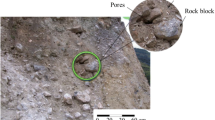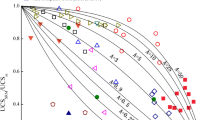Abstract
Because of spatial variability and complex compositions, the mechanical test results of natural soil–rock mixtures (SRMs) are often discrete and lack reproducibility, which has greatly restricted the practical application of the experimental findings. The objective of this study was to examine the general mechanical behavior of SRMs under the influences of some hidden factors (e.g., structural parameters, parent rock type and weathering degree). To that end, the abstraction idea was adopted to prepare purified SRM samples. Large-scale triaxial tests were performed on these purified materials. On this basis, the influences of three structural parameters on the mechanical behavior of SRMs were studied. Moreover, the relationship between the shear strength and parent rock type and that between the shear strength and the spatial distribution of rock blocks were quantified. Some additional intrinsic behavior was distinguished from individual experimental phenomena through the comparative analysis of the test data in this study and those reported in the literature. The results show that the hidden factors had significant influences on the mechanical behavior of SRMs. A greater saturated uniaxial compressive strength of rock blocks generally led to a larger shear strength of SRMs. According to the significance of their influences on the shear strength parameters of SRMs, the structural parameters are ordered as: the gradation of rock blocks, the initial dry density of sample and the spatial distribution of rock blocks. The deformation and failure feature of SRMs were considerably affected by the spatial distribution of rock blocks and shear rate. And the shear strength parameters of SRMs were mainly influenced by the content of grains between 40 and 60 mm. The findings of this study would provide useful guidance for engineering practice.














Similar content being viewed by others
References
Afifipour M, Moarefvand P (2014) Mechanical behavior of bimrocks having high rock block proportion. Int J Rock Mech Min Sci 65:40–48
Alonso EE, Romero EE, Ortega E (2016) Yielding of rockfill in relative humidity-controlled triaxial experiments. Acta Geotech 11(3):455–477
Ayers PD (1987) Moisture and density effects on soil shear strength parameters for coarse grained soils. Trans Asae 30(5):1282–1287
Cen D, Huang D, Ren F (2017) Shear deformation and strength of the interphase between the soil–rock mixture and the benched bedrock slope surface. Acta Geotech 12(2):391–413
Charles JA, Watts KS (1980) The influence of confining pressure on the shear strength of compacted rockfill. Geotechnique 30(4):353–367
Chen AJ, Zhang JS (2019) Strength and deformation characteristics of silty sand improved by gravel. KSCE J Civ Eng 23(2):525–533
Chen XB, Li ZY, Zhang JS (2014) Effect of granite gravel content on improved granular mixtures as railway subgrade fillings. J Cent South Univ 21(8):3361–3369
Coli N, Berry P, Boldini D (2011) In situ non-conventional shear tests for the mechanical characterisation of a bimrock. Int J Rock Mech Min Sci 48(1):95–102
Dong H, Huang R, Gao QF (2017) Rainfall infiltration performance and its relation to mesoscopic structural properties of a gravelly soil slope. Eng Geol 230:1–10
Duncan JM, Chang CY (1970) Nonlinear analysis of stress and strain in soils. J Soil Mech Found Div 96(5):1629–1653
De Frias Lopez R, Silfwerbrand J, Jelagin D, Birgisson B (2016) Force transmission and soil fabric of binary granular mixtures. Géotechnique 66(7):578–583
Gao QF, Dong H, Huang R, Li ZF (2019) Structural characteristics and hydraulic conductivity of an eluvial-colluvial gravelly soil. B Eng Geol Environ 78(7):5011–5028
Gao WW, Gao W, Hu RL, Xu PF, Xia JG (2018) Microtremor survey and stability analysis of a soil-rock mixture landslide: a case study in Baidian town, China. Landslides 15(10):1951–1961
Gong J, Nie Z, Zhu Y, Liang Z, Wang X (2019) Exploring the effects of particle shape and content of fines on the shear behavior of sand-fines mixtures via the DEM. Comput Geotech 106:161–176
Gao QF, Jrad M, Hattab M, Fleureau JM, Ighil Ameur L (2020) Pore morphology, porosity and pore size distribution in kaolinitic remoulded clays under triaxial loading. Int J Geomech 20(6):04020057
Gao QF, Hattab M, Jrad M, Fleureau JM, Hicher PY (2020) Microstructural organization of remoulded clays in relation with dilatancy/contractancy phenomena. Acta Geotech 15(1):223–243
Hu MJ, Pan HL, Wei HZ, Wang R, Ying A (2013) Landslides & debris flows formation from gravelly soil surface erosion and particle losses in Jiangjia Ravine. J Mt Sci 10(6):987–995
Huang S, Ding X, Zhang Y (2015) Triaxial test and mechanical analysis of rock-soil aggregate sampled from natural sliding mass. Adv Mater Sci Eng 2015:1–14
Jafari MK, Shafiee A (2004) Mechanical behavior of compacted composite clays. Can Geotech J 41(6):1152–1167
Jehring MM, Bareither CA (2016) Tailings composition effects on shear strength behavior of co-mixed mine waste rock and tailings. Acta Geotech 11(5):1147–1166
Kalender A, Sonmez H, Medley E, Tunusluoglu C, Kasapoglu KE (2014) An approach to predicting the overall strengths of unwelded bimrocks and bimsoils. Eng Geol 183:65–79
Khorasani E, Amini M, Hossaini MF, Medley E (2019) Statistical analysis of bimslope stability using physical and numerical models. Eng Geol 254:13–24
Li CS, Zhang D, Du SS, Shi B (2016) Computed tomography based numerical simulation for triaxial test of soil-rock mixture. Comput Geotech 73:179–188
Lindquist ES, Goodman RE (1994) Strength and deformation properties of a physical model melange. In: Nelson PP, Laubach SE (eds) Proceedings of the 1st North American rock mechanics symposium. Balkema, Rotterdam, pp 843–850
Liu F, Mao X, Fan Y, Wu L, Liu WV (2020) Effects of initial particle gradation and rock content on crushing behaviors of weathered phyllite fills–A case of eastern Ankang section of Shiyan-Tianshui highway China. J Rock Mech Geotech Eng 12(2):269–278
Medley EW (1999) Systematic characterization of melange bimrocks and other chaotic soil/rock mixtures. Felsbau 17(3):152–162
Meng QX, Wang HL, Xu WY, Cai M (2018) A numerical homogenization study of the elastic property of a soil-rock mixture using random mesostructure generation. Comput Geotech 98:48–57
Miller EA, Sowers GF (1958) The strength characteristics of soil-aggregate mixtures & discussion. Highw Res Board Bull 183:16–23
Muceku Y, Korini O (2014) Landslide and slope stability evaluation in the historical town of Kruja Albania. Nat Hazard Earth Syst Sci 14(3):545–556
Mulqueen J, Stafford JV, Tanner DW (1977) Evaluation of penetrometers for measuring soil strength. J Terramech 14(3):137–151
Napoli ML, Barbero M, Ravera E, Scavia C (2018) A stochastic approach to slope stability analysis in bimrocks. Int J Rock Mech Min Sci 101:41–49
Niu F, Zheng H, Li A (2018) The study of frost heave mechanism of high-speed railway foundation by field-monitored data and indoor verification experiment. Acta Geotech. https://doi.org/10.1007/s11440-018-0740-8
Panthee S, Singh PK, Kainthola A, Das R, Singh TN (2018) Comparative study of the deformation modulus of rock mass. B Eng Geol Environ 77:751–760
Seif El Dine B, Dupla JC, Frank R, Canou J, Kazan Y (2010) Mechanical characterization of matrix coarse-grained soils with a large-sized triaxial device. Can Geotech J 47(4):425–438
Shen Z (2004) Science advocates simplicity-some remarks about adopting and adapting methods in geotechnical engineering. Chin J Geotech Eng 2004(2):299–300 (in Chinese)
Shi C, Wang SN, Liu L, Meng QX, Zhang Q (2013) Mesomechanical simulation of direct shear test on outwash deposits with granular discrete element method. J Cent South Univ 20(4):1094–1102
Singh TN, Kainthola A, Venkatesh A (2012) Correlation between point load index and uniaxial compressive strength for different rock types. Rock Mech Rock Eng 45(2):259–264
Sonmez H, Kasapoglu KE, Coskun A, Tunusluoglu C, Medley EW, Zimmerman RW (2009) A conceptual empirical approach for the overall strength of unwelded bimrocks. In: ISRM Regional Symposium, Rock Engineering in Difficult Ground Condition, Soft Rock and Karst, Dubrovnik, Croatia, pp 357–360
Tang Z, Dong X, Chai B, Yang Y (2014) Evaluation of particle size distribution of coal gangue through fractal method in Dongkuang mine, Heshan, China. J Mater Civil Eng 26(8):06014018
Tuǧrul A (2004) The effect of weathering on pore geometry and compressive strength of selected rock types from Turkey. Eng Geol 75(3–4):215–227
Vallejo LE (2001) Interpretation of the limits in shear strength in binary granular mixtures. Can Geotech J 38(5):1097–1104
Wang HL, Cui YJ, Lamas-Lopez F, Calon N, Saussine G, Dupla JC, Canou J, Aimedieu P, Chen RP (2018) Investigation on the mechanical behavior of track-bed materials at various contents of coarse grains. Constr Build Mater 164:228–237
Wen R, Tan C, Wu Y, Wang C (2018) Grain size effect on the mechanical behavior of cohesionless coarse-grained soils with the discrete element method. Adv Civ Eng. https://doi.org/10.1155/2018/4608930
Wei HZ, Xu WJ, Xu XF, Meng QS, Wei CF (2018) Mechanical properties of strongly weathered rock-soil mixtures with different rock block contents. Int J Geomech 18(5):04018026
Xu W, Xu Q, Hu R (2011) Study on the shear strength of soil-rock mixture by large scale direct shear test. Int J Rock Mech Min Sci 48(8):1235–1247
Xu WJ, Yue ZQ, Hu RL (2008) Study on the mesostructure and mesomechanical characteristics of the soil-rock mixture using digital image processing based finite element method. Int J Rock Mech Min Sci 45(5):749–762
Yang H, Zhou Z, Wang X, Zhang Q (2015) Elastic modulus calculation model of a soil-rock mixture at normal or freezing temperature based on micromechanics approach. Adv Mater Sci Eng. https://doi.org/10.1155/2015/576080
Zhang HY, Xu WJ, Yu YZ (2016) Triaxial tests of soil–rock mixtures with different rock block distributions. Soils Found 56(1):44–56
Zhang ZL, Xu WJ, Xia W, Zhang HY (2016) Large-scale in situ test for mechanical characterization of soil-rock mixture used in an embankment dam. Int J Rock Mech Min Sci 86:317–322
Zhang H, Hu X, Boldini D, He C, Liu C, Ai C (2020) Evaluation of the shear strength parameters of a compacted S-RM fill using improved 2-D and 3-D limit equilibrium methods. Eng Geol. https://doi.org/10.1016/j.enggeo.2020.105550
Zhou Z, Yang H, Wang X, Liu B (2016) Model development and experimental verification for permeability coefficient of soil-rock mixture. Int J Geomech 17(4):04016106
Zhou W, Wu W, Ma G, Ng TT, Chang X (2018) Undrained behavior of binary granular mixtures with different fines contents. Powder Technol 340:139–153
Author information
Authors and Affiliations
Corresponding author
Additional information
Publisher's Note
Springer Nature remains neutral with regard to jurisdictional claims in published maps and institutional affiliations.
Rights and permissions
About this article
Cite this article
Dong, H., Peng, B., Gao, QF. et al. Study of hidden factors affecting the mechanical behavior of soil–rock mixtures based on abstraction idea. Acta Geotech. 16, 595–611 (2021). https://doi.org/10.1007/s11440-020-01045-0
Received:
Accepted:
Published:
Issue Date:
DOI: https://doi.org/10.1007/s11440-020-01045-0




